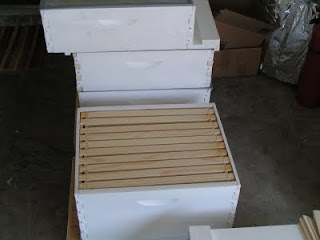27 May 2011
Bees At Work
After two weeks, we took a peek inside our hive boxes to see how our bees were doing. Both hives have started "drawing" comb. That is a good sign. It means that they have established some food sources and are making cells to manufacture and store honey. It is essential that the bees have sufficient honey stores before winter comes - that is what they will rely on to sustain them through the cold winter months. However,we were disappointed that they hadn't drawn the quantity of comb that we were expecting. I contacted our bee expert - Bill the Bee Guy and he advised installing an internal feeder to supplement them with a sugar water formula.

Cover and "ladder" for internal feeder

Feeder
The "ladder" inside the feeder is used by the bees to walk into the feeder without drowning. We installed the feeder and in a couple of weeks "we" will go back inside and see how they are doing.

My Beekeeper At Work
(notice he isn't wearing his bee suit or gloves???)




